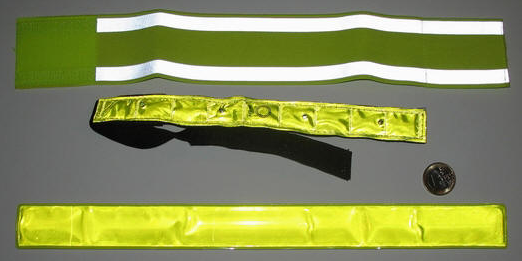There are fatal accidents when a driver strikes a pedestrian because he overlooked it. This happens especially in the village, at night, when the pedestrian moves on the road in dark clothes and on a dark background, when it is virtually invisible. I make one of the suggestions on how to deal with this situation.
Different reflective elements for pedestrians compared to one Euro coin. Reflective velcro tape. In the middle reflective tape with own source and flashing LEDs, also with Velcro. Below is the most commonly used reflective tape with an internal spring.
Special provisions on pedestrians
Pedestrians may walk along the side of the road or the edge of the road at most two side by side, provided that they do not endanger or restrict road traffic, especially in reduced visibility or increased traffic; this does not apply to persons moving on the shoulder or on the edge of the road on skis, skates or similar sports equipment, which can only move in a row. From sunset to sunrise and in poor visibility, a pedestrian walking on the road or the edge of the road, inside and outside the village, shall have visibly placed reflective elements or wearing reflective safety clothing, so that it can be seen by drivers coming from both sides. This obligation shall not apply in the case of the transverse passage of the road at controlled pedestrian crossings or illuminated and uncontrolled pedestrian crossings.
Rationale:
By extending the obligation of reflective elements from outside the municipality to the municipality, pedestrians will be especially visible in villages where there are no sidewalks and use the road to move.
The obligation to be seen by drivers from both sides will eliminate the deficiency when the pedestrian had a reflective element only on his back, most often on his backpack. As a result, when walking along the opposite road surface not seen for incoming drivers.
By using the terminology from sunset to sunrise, which is common in aviation, we can easily and accurately determine the time from when to when it is required to use reflective materials.
To avoid unnecessarily burdensome pedestrians in well-lit city centers, this obligation is not at pedestrian crossings, in addition to footpaths. This also means that pedestrians without reflective elements will have to use pedestrian crossings as a priority.
